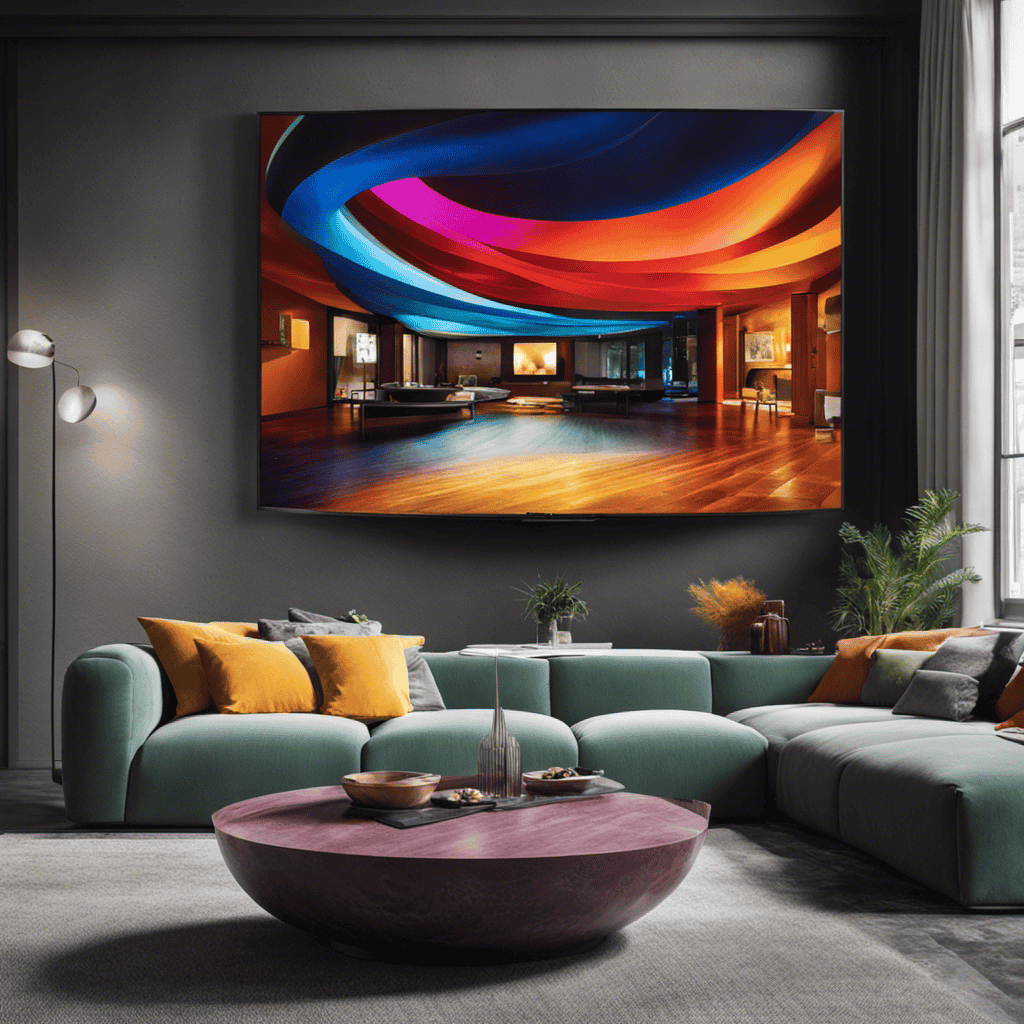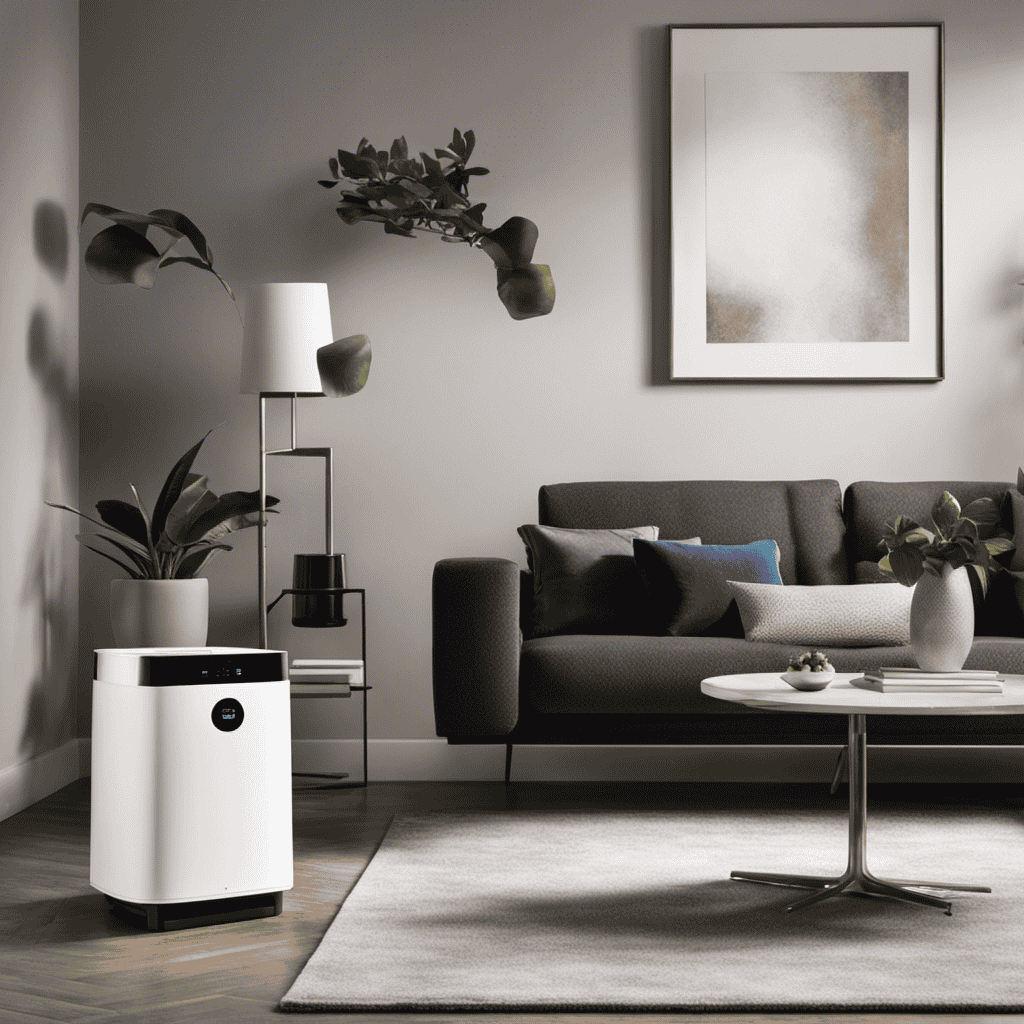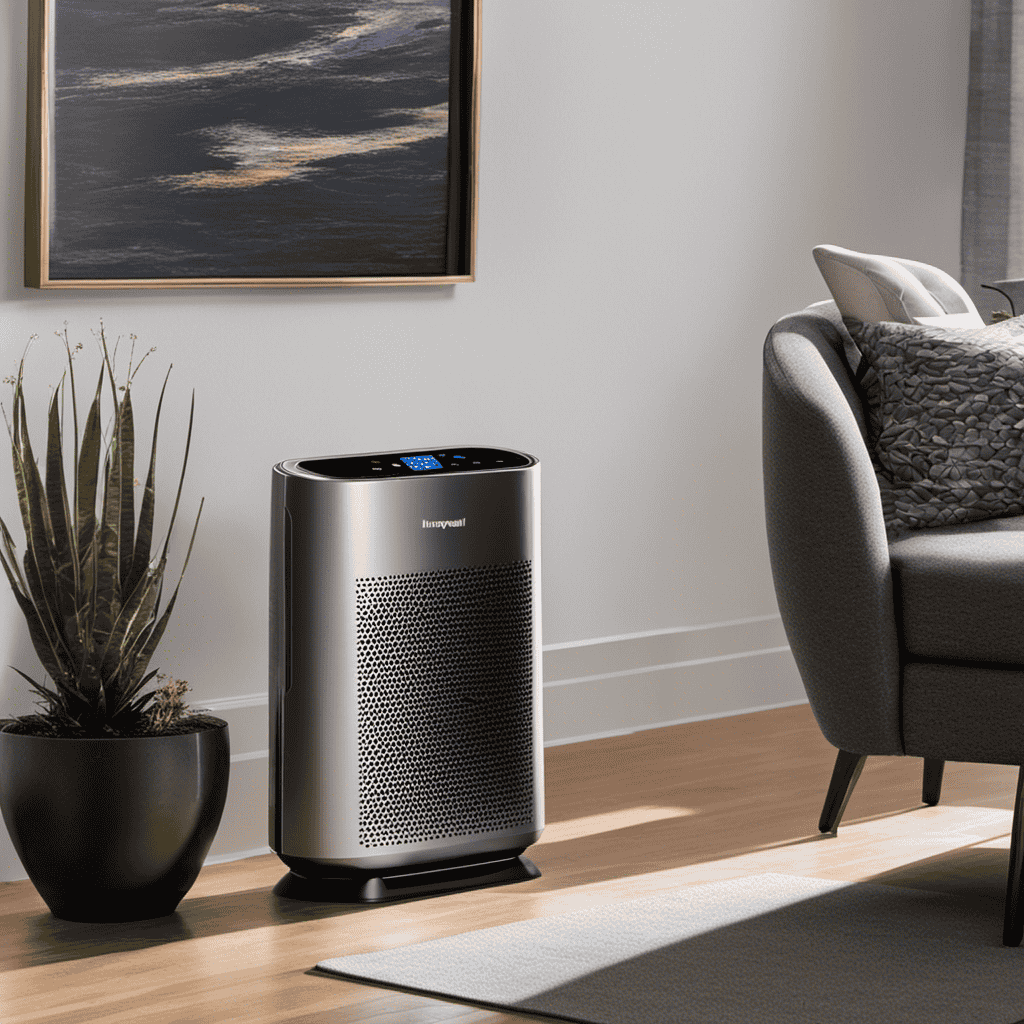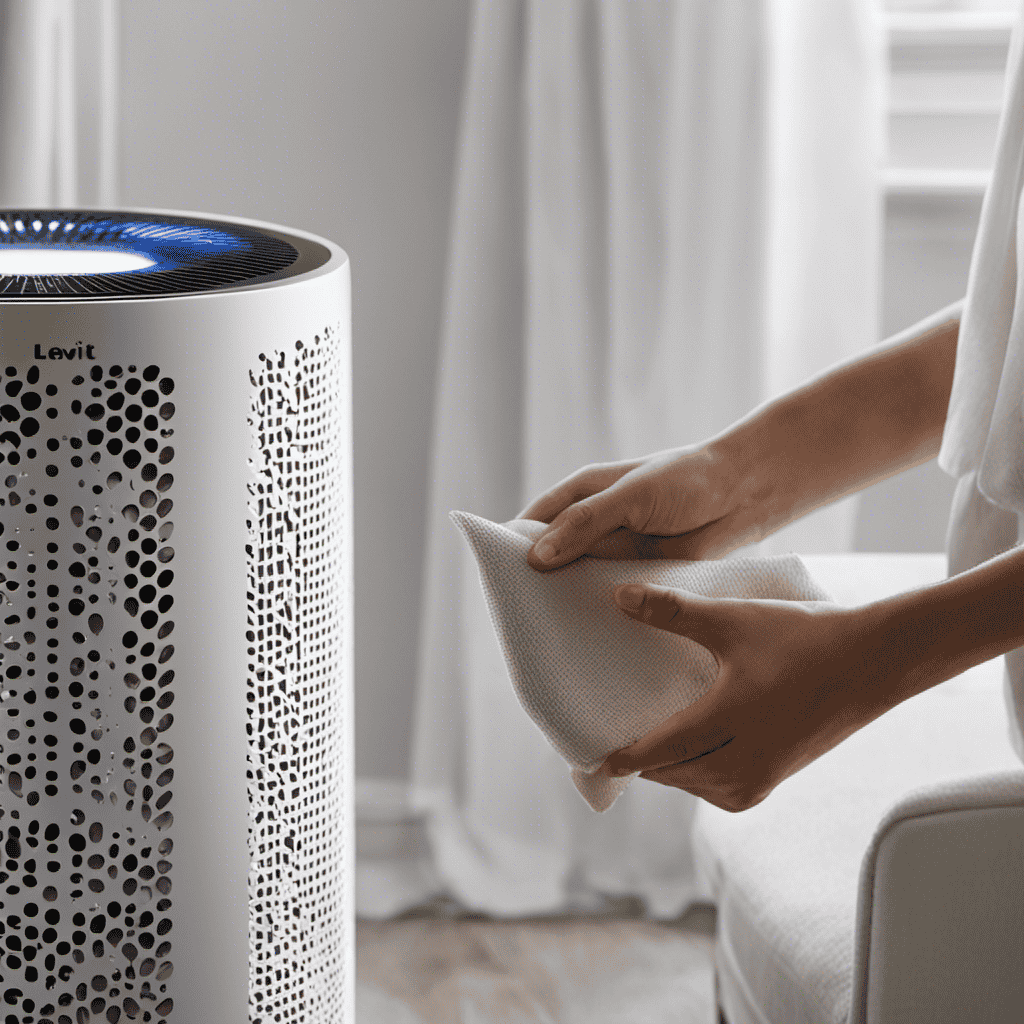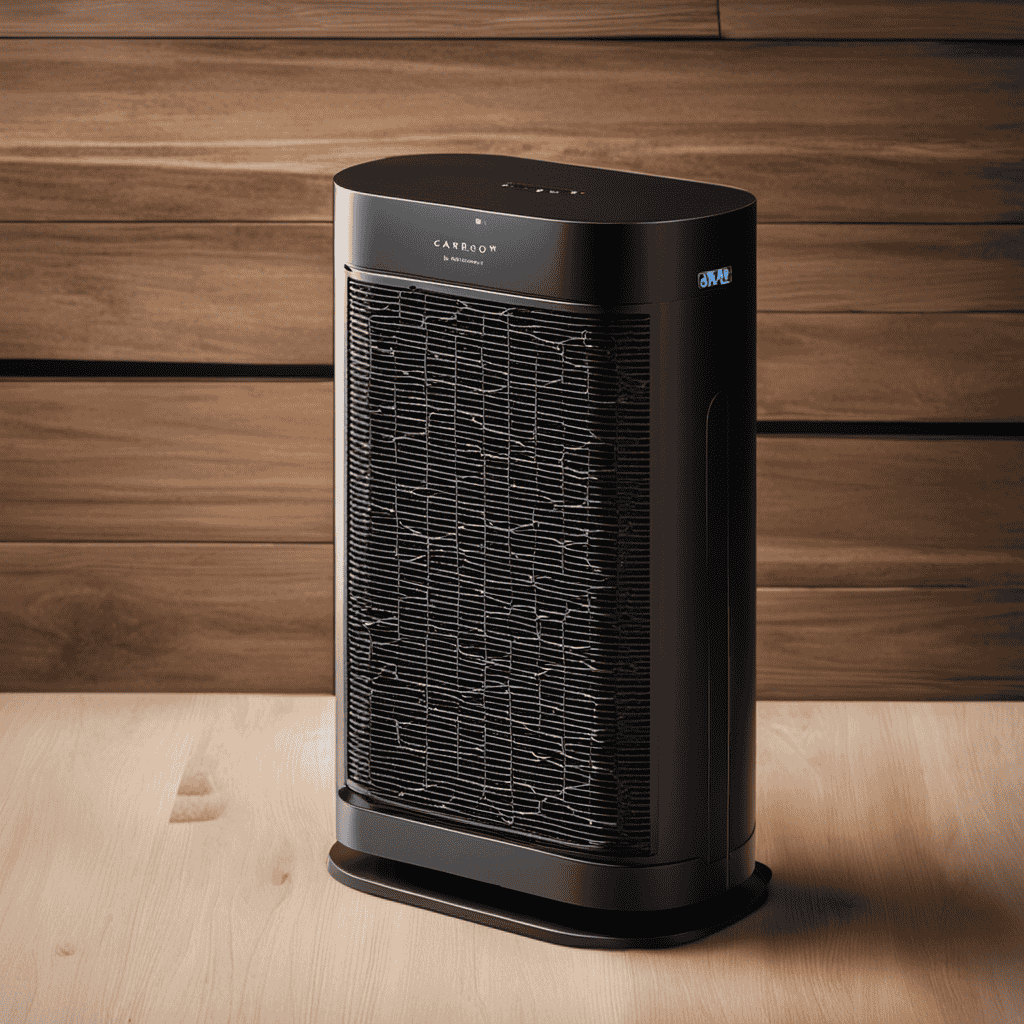As a passionate consumer who values clean and fresh air, I often review CADR ratings to guarantee the best indoor air quality.
In this article, we will delve into the intricacies of CADR ratings, exploring their significance and how they are determined.
We will also discuss the correlation between CADR ratings and allergen removal, as well as their effectiveness in reducing smoke and odor.
Furthermore, we will uncover the benefits of higher CADR ratings for individuals with asthma and allergies.
However, it is important to acknowledge the limitations and considerations when solely relying on CADR ratings.
Let’s begin our journey into the world of CADR ratings and its impact on our well-being.
Key Takeaways
- CADR ratings measure an air purifier’s effectiveness in removing pollutants from the air.
- CADR ratings provide reliable and valid information about air purifier performance.
- CADR results help determine the efficiency of air purifiers in removing pollutants.
- Factors such as particle size, room size, air exchange rate, filter maintenance, and environmental conditions can affect CADR ratings.
What Is a CADR Rating
A CADR rating measures the air purifier’s effectiveness in removing pollutants from the air. The CADR testing process involves subjecting the air purifier to a standardized set of tests to determine its performance. These tests are conducted in a controlled environment using specific pollutants such as tobacco smoke, pollen, and dust. During the testing process, the air purifier is placed in a chamber where these pollutants are introduced at a specific concentration. The air purifier then works to remove these pollutants from the air, and the CADR rating is calculated based on the rate at which the pollutants are removed.
Accuracy is an important aspect of CADR ratings. To ensure accuracy, the testing process follows strict guidelines and protocols set by organizations such as the Association of Home Appliance Manufacturers (AHAM). These guidelines specify the test conditions, pollutant concentration, and duration for which the air purifier is tested. By adhering to these guidelines, the CADR rating provides a reliable measure of an air purifier’s performance in removing specific pollutants.
It’s important to note that CADR ratings only measure the effectiveness of an air purifier in removing specific pollutants and do not consider other factors such as noise level, energy consumption, or overall air quality improvement. Therefore, it’s recommended to consider other factors in addition to CADR ratings when choosing an air purifier for your specific needs.
Understanding the CADR Testing Process
When it comes to CADR ratings, it’s important to understand their reliability and validity.
Reliability refers to the consistency of the test results, ensuring that the measurements are accurate and reproducible.
Validity, on the other hand, ensures that the test is measuring what it claims to measure.
Interpreting CADR results involves understanding the numerical values and comparing them to the recommended levels for different room sizes.
It also involves considering other factors such as the type of pollutant being tested.
CADR Reliability and Validity
The CADR ratings are intended to provide reliable and valid information about air purifier performance. Accuracy in CADR testing is crucial to ensure that consumers can trust the ratings when making purchasing decisions.
To maintain accuracy, CADR testing follows strict standards set by regulatory bodies. These standards outline the testing procedures and requirements that manufacturers must adhere to. By following these standards, the testing process becomes standardized, reducing the chances of errors or biases.
This ensures that the CADR ratings reflect the true performance of air purifiers in removing smoke, pollen, and dust from the air. The reliability and validity of CADR ratings are essential in helping consumers choose air purifiers that effectively improve indoor air quality.
Interpreting CADR Results
Interpreting CADR results can be helpful in determining the effectiveness of air purifiers in removing smoke, pollen, and dust from the air. The CADR rating, or Clean Air Delivery Rate, is a metric that measures the efficiency of an air purifier in filtering out these pollutants.
By analyzing the CADR data, consumers can make informed decisions about which air purifier is best suited for their needs. However, it is important to consider the accuracy of the CADR rating. The CADR rating is determined through standardized testing, but it may not always reflect real-world conditions.
Factors such as room size, air flow, and pollutant concentration can affect the actual performance of an air purifier. Therefore, it is crucial to understand the limitations of the CADR rating and consider other factors when choosing the right CADR rating for your needs.
The Importance of Choosing the Right CADR Rating for Your Needs
To ensure you select the right CADR rating for your needs, consider factors such as room size and specific air quality concerns. Here are some important points to keep in mind:
-
Room Size: The CADR rating is calculated based on the size of the room. A larger room will require a higher CADR rating to effectively clean the air.
-
Air Quality Concerns: Different air pollutants require different CADR ratings for efficient removal. Consider your specific concerns, such as allergies, pet dander, or smoke, to determine the appropriate CADR rating.
-
CADR Testing Process: The CADR rating is determined through rigorous testing conducted by independent laboratories. These tests measure the device’s ability to remove smoke, pollen, and dust particles from the air.
-
Higher CADR Ratings: A higher CADR rating indicates a faster and more efficient air purification process. If you have severe allergies or live in an area with high pollution levels, it is advisable to choose a device with a higher CADR rating.
-
Maintenance: Keep in mind that maintaining your air purifier is crucial for optimal performance. Regularly cleaning and replacing filters will ensure that the CADR rating remains accurate and effective.
Tips for Interpreting CADR Ratings
When considering air purifiers, it’s important to understand how CADR ratings can help you choose the right one for your needs. CADR, or Clean Air Delivery Rate, is a measure of an air purifier’s effectiveness in removing specific pollutants from the air. It provides a standardized way to compare different models and determine which one will provide the best air quality for your space.
Interpreting CADR ratings involves understanding the three main categories: smoke, pollen, and dust. Each category has its own CADR rating, which indicates the amount of particles the air purifier can remove per minute. The higher the CADR rating, the more effective the air purifier is in eliminating that specific pollutant.
To choose the right CADR rating for your needs, you should consider the size of the room you want to purify. The Association of Home Appliance Manufacturers (AHAM) recommends that the CADR rating for an air purifier should be at least two-thirds the size of the room in square feet. This ensures that the air purifier can effectively clean the air in your space.
Exploring the Different CADR Rating Categories
If you explore the different CADR rating categories, you’ll gain a better understanding of how effective an air purifier is in removing specific pollutants. CADR, or Clean Air Delivery Rate, is a measurement of an air purifier’s ability to remove certain airborne particles from a specific area. The accuracy of CADR ratings is crucial in determining the efficiency of an air purifier.
However, there are several factors that can affect the accuracy of these ratings.
Here are five factors that can affect CADR ratings:
-
Particle size: CADR ratings are based on the removal of particles of specific sizes, such as smoke, dust, and pollen. If an air purifier is not designed to effectively remove particles of a certain size, its CADR rating may not accurately reflect its performance.
-
Room size: CADR ratings are calculated based on a specific room size. If the room you are using the air purifier in is larger or smaller than the rated size, the effectiveness of the purifier may vary.
-
Air exchange rate: The CADR rating assumes a certain number of air exchanges per hour. If the air purifier does not achieve the specified air exchange rate, its effectiveness in removing pollutants may be compromised.
-
Filter maintenance: CADR ratings are based on the assumption that the air purifier’s filters are clean and functioning properly. If the filters are not regularly cleaned or replaced, the CADR rating may not accurately represent the purifier’s performance.
-
Environmental conditions: CADR ratings are determined under specific laboratory conditions. Factors such as temperature, humidity, and the presence of other pollutants in the environment can affect the performance of an air purifier and its ability to achieve the rated CADR.
The Impact of CADR Ratings on Indoor Air Quality
When comparing CADR ratings to IAQ standards, it is important to consider the differences in their measurement methods and thresholds.
While CADR ratings focus on the effectiveness of air purifiers in removing specific pollutants, IAQ standards take into account a broader range of factors that contribute to overall indoor air quality.
The validity of CADR ratings can be questioned due to potential biases in testing methods and the limited scope of pollutants considered, highlighting the need for more comprehensive and standardized evaluation metrics.
Furthermore, consumer awareness and education are crucial in ensuring that individuals make informed decisions about air purifiers and understand the limitations of CADR ratings in assessing overall indoor air quality.
CADR Vs. IAQ Standards
You need to understand the difference between CADR and IAQ standards. CADR measures the efficiency of air purifiers in removing specific pollutants from the air, while IAQ standards refer to the overall quality of the air in a given space.
Here are five key points to consider when comparing CADR and IAQ standards:
-
CADR testing process: CADR ratings are determined through standardized testing procedures that measure the air purifier’s effectiveness in removing smoke, pollen, and dust particles from the air.
-
Specific pollutant removal: CADR focuses on the removal of specific pollutants, while IAQ standards encompass a broader range of factors such as temperature, humidity, and the presence of volatile organic compounds (VOCs).
-
Certification requirements: Air purifiers can be certified with CADR ratings, while IAQ standards are typically set by regulatory bodies or organizations.
-
Consumer guidance: CADR ratings provide consumers with a standardized way to compare different air purifiers based on their pollutant removal efficiency.
-
Comprehensive air quality assessment: IAQ standards take into account various factors that contribute to overall air quality, ensuring a more comprehensive assessment of the indoor environment.
Understanding the differences between CADR and IAQ standards is crucial in making informed decisions when it comes to selecting the right air purifier for your needs.
Validity of CADR
To determine the effectiveness of an air purifier, it’s important to consider the validity of CADR measurements. CADR, or Clean Air Delivery Rate, is a standardized method used to measure the performance of air purifiers in removing three common pollutants: smoke, pollen, and dust. However, the accuracy of CADR ratings can vary depending on the testing methods used. Different testing laboratories may employ different protocols and conditions, leading to inconsistencies in the results. Additionally, the CADR rating only provides information about the efficiency of an air purifier in removing specific particles, and it does not take into account other factors such as noise levels or energy consumption. Therefore, while CADR ratings can be a helpful tool in comparing air purifiers, it is important to consider other factors and conduct thorough research before making a purchasing decision.
| CADR Rating | Testing Method | Accuracy |
|---|---|---|
| Smoke | Testing with tobacco smoke particles | Moderate |
| Pollen | Testing with artificial pollen particles | High |
| Dust | Testing with standardized dust particles | Low |
Table: CADR Testing Methods and Accuracy
Consumer Awareness and Education
Consumer awareness and education play a crucial role in understanding the effectiveness of air purifiers. When it comes to improving indoor air quality, consumers need to be well-informed to make the right decisions. Here are five key points to consider:
-
The importance of regular maintenance: Consumers should be aware that air purifiers require regular maintenance, including filter replacements and cleaning, to ensure optimal performance.
-
Different types of air pollutants: Consumers should understand the various types of air pollutants, such as dust, pollen, pet dander, and volatile organic compounds (VOCs), and choose air purifiers that effectively target these specific pollutants.
-
Room size and air purifier capacity: Consumers need to consider the size of the room where the air purifier will be used and choose a unit with the appropriate Clean Air Delivery Rate (CADR) to effectively clean the air.
-
Noise level: Consumers should be aware of the noise level produced by air purifiers, especially if they plan to use them in bedrooms or other quiet areas.
-
Energy efficiency: Consumers should look for energy-efficient air purifiers to minimize energy consumption and reduce long-term operating costs.
Understanding these factors will help consumers make informed decisions when selecting air purifiers.
Now, let’s explore the factors that can affect CADR ratings.
Factors That Can Affect CADR Ratings
When selecting an air purifier, it’s important to consider factors that can affect CADR ratings. CADR, or Clean Air Delivery Rate, is a measurement of how effectively an air purifier can remove pollutants from the air. Several factors can impact CADR ratings, and understanding these factors can help consumers make an informed decision.
One factor that can affect CADR ratings is the size of the air purifier. Generally, larger air purifiers have a higher CADR rating because they have a larger fan and can move more air.
The type of filter used in the air purifier is another factor that can impact CADR ratings. Different filters have different levels of efficiency in removing pollutants, and this can affect the overall CADR rating.
Additionally, the speed settings of the air purifier can also impact CADR ratings. Higher speed settings can result in higher CADR ratings, as more air is being circulated and purified. However, it’s important to note that higher speed settings also consume more energy.
Comparing CADR Ratings Among Different Air Purifiers
When comparing CADR ratings among different air purifiers, it’s important to consider the accuracy and reliability of the CADR measurements.
CADR stands for Clean Air Delivery Rate and it is a standardized measurement that indicates how effectively an air purifier can remove pollutants from the air.
Factors such as room size, filter efficiency, and fan speed can all affect CADR ratings, so it is crucial to understand these factors when interpreting CADR results.
CADR Accuracy and Reliability
The CADR ratings may not always be completely accurate or reliable. While they provide a useful benchmark for comparing air purifiers, it’s important to understand their limitations. Here are five factors to consider when assessing CADR ratings:
-
CADR Testing Methods: Different manufacturers may use different testing methods, resulting in variations in the reported CADR values.
-
Air Purifier Effectiveness: CADR ratings directly impact the effectiveness of an air purifier in removing specific pollutants from the air.
-
Particle Size: CADR ratings are typically based on the removal of particles of a specific size, and may not reflect the purifier’s performance with other particle sizes.
-
Room Size: CADR ratings are determined in laboratory conditions and may not accurately represent the performance of the purifier in different room sizes or environments.
-
Maintenance: The CADR ratings assume that the air purifier is properly maintained and filters are regularly replaced.
Understanding these factors will allow consumers to make more informed decisions when choosing an air purifier.
Now let’s explore the various factors that can affect CADR ratings.
Factors Affecting CADR Ratings
To understand how CADR ratings can be affected, you should consider factors such as testing methods, air purifier effectiveness, particle size, room size, and maintenance. The accuracy and reliability of CADR ratings can vary depending on these factors. Testing methods play a crucial role in determining the CADR rating of an air purifier. Different organizations may use different methods, leading to variations in the results. The effectiveness of the air purifier itself also affects the CADR rating. If the purifier is not designed to effectively remove specific particles, the CADR rating may be lower than expected. Particle size is another factor to consider. CADR ratings are typically based on specific particle sizes, and the purifier may perform differently for particles of different sizes. Additionally, the size of the room where the air purifier is used can impact the CADR rating. A smaller room may experience higher CADR, while a larger room may have lower CADR due to dilution of the clean air. Finally, maintenance of the air purifier, such as filter replacement and regular cleaning, can also affect the CADR rating. Overall, it is important to understand these factors and their limitations to accurately interpret and compare CADR ratings.
| Factors Affecting CADR Ratings | Limitations of CADR Ratings |
|---|---|
| Testing Methods | Variation in results |
| Air Purifier Effectiveness | Ineffective particle removal |
| Particle Size | Different performance for different sizes |
| Room Size | Higher CADR in smaller rooms, lower CADR in larger rooms |
| Maintenance | Neglecting maintenance affects CADR rating |
Interpreting CADR Results
You can interpret CADR results by comparing the effectiveness of different air purifiers in removing specific particles based on their CADR ratings. Understanding these results can help you make an informed decision when choosing an air purifier for your home.
Here are some key factors to consider when interpreting CADR results:
-
Particle type: CADR ratings are specific to different particles such as dust, pollen, and smoke. Comparing the CADR ratings for these particles can give you an idea of how well an air purifier can remove them.
-
Room size: CADR ratings are typically given for specific room sizes. It is important to choose an air purifier with a CADR rating appropriate for the size of your room.
-
Speed settings: Different air purifiers may have multiple speed settings. Comparing the CADR ratings at different speeds can help you understand the trade-off between filtration efficiency and noise level.
-
Filter replacement: CADR ratings are based on the assumption that the filters are clean. Regularly replacing the filters is crucial to maintain the effectiveness of the air purifier.
-
Other features: While CADR ratings provide valuable information about an air purifier’s performance, it is also important to consider other features such as noise level, energy efficiency, and additional filtration technologies.
Understanding these factors will enable you to make an informed decision when comparing different air purifiers based on their CADR ratings.
Now, let’s move on to how you can calculate the CADR rating for your specific room size.
How to Calculate the CADR Rating for Your Specific Room Size
When determining the CADR rating for your specific room size, it’s important to consider the square footage and the recommended air changes per hour. Calculating CADR ratings is a straightforward process that can help you determine if an air purifier is suitable for your room size.
To calculate the CADR rating, you need to know the square footage of your room and the recommended air changes per hour based on the level of air pollution. The Association of Home Appliance Manufacturers (AHAM) recommends three to six air changes per hour for optimal air quality.
First, measure the length and width of your room to determine the square footage. Multiply these two numbers to get the total square footage.
Next, multiply the square footage by the recommended air changes per hour. For example, if you have a 200 square foot room and the recommended air changes per hour is four, you would multiply 200 by four to get a CADR rating of 800.
This calculation helps you understand if the air purifier is suitable for your room size. If the CADR rating is too high, the air purifier may be too powerful for your room. On the other hand, if the CADR rating is too low, the air purifier may not be able to effectively clean the air in your room.
The Relationship Between CADR Ratings and Allergen Removal
Understanding the relationship between CADR ratings and allergen removal is essential for selecting the right air purifier for your specific needs. The CADR rating, or Clean Air Delivery Rate, measures the effectiveness of an air purifier in removing specific airborne pollutants, including allergens. By considering the CADR rating in relation to allergen removal, you can ensure that you choose an air purifier that will effectively improve the air quality in your home or office.
Here are five key points to consider when it comes to the relationship between CADR ratings and allergen removal effectiveness:
-
CADR rating correlates with air purifier performance: The higher the CADR rating, the more effective the air purifier is at removing allergens from the air.
-
CADR ratings are specific to different types of allergens: CADR ratings are typically provided for three main types of airborne pollutants: smoke, pollen, and dust. Make sure to look for an air purifier that has a high CADR rating for the specific allergens you are concerned about.
-
Higher CADR ratings mean faster allergen removal: Air purifiers with higher CADR ratings can remove allergens from the air at a faster rate, leading to quicker relief from allergy symptoms.
-
Room size and CADR rating relationship: It is important to consider the size of the room where the air purifier will be used. A higher CADR rating is recommended for larger rooms to ensure effective allergen removal.
-
Additional features enhance allergen removal: Some air purifiers come with additional features, such as HEPA filters or activated carbon filters, which further enhance their ability to remove allergens effectively.
The Role of CADR Ratings in Reducing Smoke and Odor
The role of CADR ratings in reducing smoke and odor can be better understood by considering how higher ratings indicate a more effective air purifier.
CADR, or Clean Air Delivery Rate, measures an air purifier’s ability to remove smoke, dust, and pollen from the air. When it comes to reducing smoke and odor, the interplay between CADR ratings and air purifier technology is crucial.
Higher CADR ratings mean that the air purifier can remove smoke and odor particles from the air more efficiently. This is because a higher CADR rating indicates a higher volume of clean air being delivered per minute. Air purifiers with higher CADR ratings have more powerful fans and filters, allowing them to effectively capture and eliminate smoke and odor particles.
The impact of CADR ratings on purchasing decisions cannot be understated. Consumers looking for an air purifier specifically to reduce smoke and odor will prioritize models with higher CADR ratings. These ratings provide an objective measure of an air purifier’s performance, helping consumers make informed choices.
The Benefits of Higher CADR Ratings for Asthma and Allergy Sufferers
If you suffer from asthma or allergies, higher CADR ratings can greatly benefit you. When it comes to air purifiers, CADR (Clean Air Delivery Rate) ratings indicate how effectively the device can remove airborne particles from the air. Here are some key benefits of higher CADR ratings for asthma and allergy sufferers:
-
Improved Air Quality: Higher CADR ratings mean that the air purifier can remove a larger volume of pollutants from the air, helping to create a cleaner and healthier indoor environment.
-
Reduced Asthma Symptoms: Asthma sufferers often experience symptoms triggered by allergens and irritants in the air. With higher CADR ratings, air purifiers can efficiently remove these triggers, leading to a reduction in asthma symptoms.
-
Allergen Control: Allergy sufferers are particularly sensitive to allergens such as pollen, dust mites, and pet dander. Air purifiers with higher CADR ratings can effectively capture and remove these allergens, providing relief from allergy symptoms.
-
Smoke and Odor Removal: Higher CADR ratings also indicate better smoke and odor removal capabilities. This is especially beneficial for asthma and allergy sufferers who may be sensitive to these triggers.
-
Enhanced Sleep Quality: By removing airborne irritants, air purifiers with higher CADR ratings can create a cleaner and more allergen-free sleeping environment. This can lead to improved sleep quality for asthma and allergy sufferers.
Limitations and Considerations When Relying on CADR Ratings
When relying on CADR ratings, it’s important to consider other factors to ensure the effectiveness of an air purifier for your specific needs. While CADR ratings provide a useful measure of an air purifier’s ability to remove airborne particles, they have certain limitations that should be taken into account.
One limitation is that CADR ratings only focus on the removal of three specific types of particles: tobacco smoke, pollen, and dust. This means that an air purifier with a high CADR rating for these particles may not be as effective at removing other types of pollutants, such as pet dander or volatile organic compounds (VOCs). Therefore, it’s important to consider your specific indoor air quality concerns and choose an air purifier that targets those pollutants.
Another consideration is the size of the room where the air purifier will be used. CADR ratings are based on the assumption that the air purifier is being used in a room of a specific size. If you plan to use the air purifier in a larger or smaller room, its effectiveness may be compromised. In such cases, it’s recommended to choose an air purifier with a higher CADR rating or consider multiple units for better coverage.
In addition to CADR ratings, it’s important to consider other features and technologies offered by air purifiers, such as HEPA filters, activated carbon filters, and UV-C light. These can enhance the overall performance and effectiveness of the air purifier in removing a wider range of pollutants.
What is the CADR rating of air purifiers available on Amazon?
When researching Amazon air purifier pricing information, it’s important to consider the CADR rating. The CADR, or Clean Air Delivery Rate, measures how quickly an air purifier can filter three common indoor air pollutants: tobacco smoke, dust, and pollen. A higher CADR rating indicates better air purification efficiency.
Frequently Asked Questions
Can CADR Ratings Be Used to Compare Air Purifiers With Different Technologies?
Yes, Cadr ratings can be used to compare air purifiers with different technologies. Cadr ratings measure the effectiveness of air purifiers in removing specific pollutants from the air. By looking at the Cadr ratings of different air purifiers, you can get an idea of how well each one performs in terms of removing pollutants like smoke, dust, and pollen.
This allows you to compare air purifiers with different technologies and determine which one is more efficient in improving the air quality in your space.
Are There Any Specific CADR Ratings Recommended for People With Respiratory Conditions Like Asthma or Allergies?
When it comes to respiratory conditions like asthma or allergies, it is important to consider specific CADR ratings for air purifiers. These ratings indicate the effectiveness of an air purifier in removing pollutants from the air, such as pollen, dust, and pet dander.
How Do CADR Ratings Impact the Removal of Specific Allergens Like Dust Mites or Pet Dander?
When considering the effectiveness of air purifiers in removing specific allergens like dust mites or pet dander, it is important to understand the impact of CADR ratings.
CADR ratings measure the purifier’s ability to filter out certain particles from the air.
Choosing the right CADR rating for specific allergens is crucial to ensure that the purifier can effectively remove them.
Can CADR Ratings Accurately Predict the Effectiveness of an Air Purifier in Removing Volatile Organic Compounds (Vocs)?
CADR ratings are a useful tool for evaluating air purifiers, but they may not accurately predict the effectiveness of removing volatile organic compounds (VOCs). While CADR ratings measure the purification speed for specific particles like dust mites or pet dander, they don’t specifically address VOCs.
To determine the effectiveness of an air purifier in removing VOCs, it’s important to consider additional factors such as the type of filter used and the air quality standards set by regulatory agencies.
Are There Any Other Factors Besides CADR Ratings That Should Be Considered When Choosing an Air Purifier for a Specific Room Size?
When choosing an air purifier for a specific room size, there are several factors to consider besides CADR ratings.
For example, the layout of the room and the presence of furniture or obstacles can affect the purifier’s effectiveness.
Additionally, the type of pollutants present in the room, such as dust, pet dander, or smoke, should be taken into account.
It is also important to consider the noise level of the air purifier and its energy consumption to ensure it meets your needs.
Conclusion
In conclusion, choosing the right CADR rating is crucial for ensuring clean and healthy indoor air. The CADR testing process provides an objective measure of a purifier’s performance in removing allergens, smoke, and odors. By understanding and interpreting CADR ratings, consumers can make informed decisions when selecting air purifiers that best suit their needs.
Just like a lighthouse guiding ships through treacherous waters, CADR ratings serve as a beacon of reliability and effectiveness, particularly for asthma and allergy sufferers. However, it’s important to keep in mind that CADR ratings have limitations and should be considered alongside other factors when making a purchase decision.
